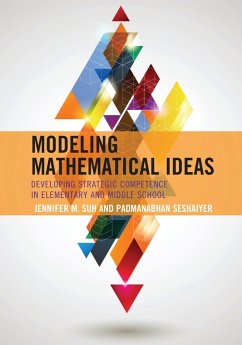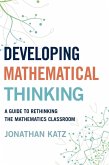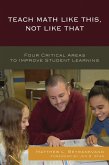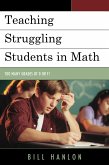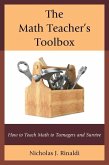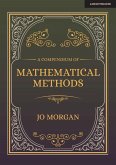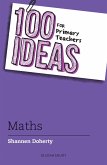Jennifer M. Suh, Padmanabhan Seshaiyer
Modeling Mathematical Ideas (eBook, ePUB)
Developing Strategic Competence in Elementary and Middle School
36,95 €
36,95 €
inkl. MwSt.
Sofort per Download lieferbar

18 °P sammeln
36,95 €
Als Download kaufen

36,95 €
inkl. MwSt.
Sofort per Download lieferbar

18 °P sammeln
Jetzt verschenken
Alle Infos zum eBook verschenken
36,95 €
inkl. MwSt.
Sofort per Download lieferbar
Alle Infos zum eBook verschenken

18 °P sammeln
Jennifer M. Suh, Padmanabhan Seshaiyer
Modeling Mathematical Ideas (eBook, ePUB)
Developing Strategic Competence in Elementary and Middle School
- Format: ePub
- Merkliste
- Auf die Merkliste
- Bewerten Bewerten
- Teilen
- Produkt teilen
- Produkterinnerung
- Produkterinnerung

Bitte loggen Sie sich zunächst in Ihr Kundenkonto ein oder registrieren Sie sich bei
bücher.de, um das eBook-Abo tolino select nutzen zu können.
Hier können Sie sich einloggen
Hier können Sie sich einloggen
Sie sind bereits eingeloggt. Klicken Sie auf 2. tolino select Abo, um fortzufahren.

Bitte loggen Sie sich zunächst in Ihr Kundenkonto ein oder registrieren Sie sich bei bücher.de, um das eBook-Abo tolino select nutzen zu können.
Modeling Mathematical Ideas combining current research and practical strategies to build teachers and students strategic competence in problem solving.This must-have book supports teachers in understanding learning progressions that addresses conceptual guiding posts as well as students' common misconceptions in investigating and discussing important mathematical ideas related to number sense, computational fluency, algebraic thinking and proportional reasoning. In each chapter, the authors opens with a rich real-world mathematical problem and presents classroom strategies (such as visible…mehr
- Geräte: eReader
- mit Kopierschutz
- eBook Hilfe
- Größe: 9.63MB
Andere Kunden interessierten sich auch für
![Developing Mathematical Thinking (eBook, ePUB) Developing Mathematical Thinking (eBook, ePUB)]() Jonathan D. KatzDeveloping Mathematical Thinking (eBook, ePUB)29,95 €
Jonathan D. KatzDeveloping Mathematical Thinking (eBook, ePUB)29,95 €![Teach Math Like This, Not Like That (eBook, ePUB) Teach Math Like This, Not Like That (eBook, ePUB)]() Matthew L. BeyranevandTeach Math Like This, Not Like That (eBook, ePUB)20,95 €
Matthew L. BeyranevandTeach Math Like This, Not Like That (eBook, ePUB)20,95 €![Teaching Struggling Students in Math (eBook, ePUB) Teaching Struggling Students in Math (eBook, ePUB)]() Bill HanlonTeaching Struggling Students in Math (eBook, ePUB)24,95 €
Bill HanlonTeaching Struggling Students in Math (eBook, ePUB)24,95 €![The Math Teacher's Toolbox (eBook, ePUB) The Math Teacher's Toolbox (eBook, ePUB)]() Nicholas J. RinaldiThe Math Teacher's Toolbox (eBook, ePUB)21,95 €
Nicholas J. RinaldiThe Math Teacher's Toolbox (eBook, ePUB)21,95 €![A Compendium Of Mathematical Methods: A handbook for school teachers (eBook, ePUB) A Compendium Of Mathematical Methods: A handbook for school teachers (eBook, ePUB)]() Joanne MorganA Compendium Of Mathematical Methods: A handbook for school teachers (eBook, ePUB)11,99 €
Joanne MorganA Compendium Of Mathematical Methods: A handbook for school teachers (eBook, ePUB)11,99 €![100 Ideas for Primary Teachers: Maths (eBook, ePUB) 100 Ideas for Primary Teachers: Maths (eBook, ePUB)]() Shannen Doherty100 Ideas for Primary Teachers: Maths (eBook, ePUB)12,95 €
Shannen Doherty100 Ideas for Primary Teachers: Maths (eBook, ePUB)12,95 €![Foundations of Mathematical Thought: The Language of Numbers (eBook, ePUB) Foundations of Mathematical Thought: The Language of Numbers (eBook, ePUB)]() ThrFoundations of Mathematical Thought: The Language of Numbers (eBook, ePUB)4,99 €
ThrFoundations of Mathematical Thought: The Language of Numbers (eBook, ePUB)4,99 €-
-
-
Modeling Mathematical Ideas combining current research and practical strategies to build teachers and students strategic competence in problem solving.This must-have book supports teachers in understanding learning progressions that addresses conceptual guiding posts as well as students' common misconceptions in investigating and discussing important mathematical ideas related to number sense, computational fluency, algebraic thinking and proportional reasoning. In each chapter, the authors opens with a rich real-world mathematical problem and presents classroom strategies (such as visible thinking strategies & technology integration) and other related problems to develop students' strategic competence in modeling mathematical ideas.
Produktdetails
- Produktdetails
- Verlag: Bloomsbury eBooks US
- Seitenzahl: 220
- Erscheinungstermin: 27. Dezember 2016
- Englisch
- ISBN-13: 9781475817607
- Artikelnr.: 47466877
- Verlag: Bloomsbury eBooks US
- Seitenzahl: 220
- Erscheinungstermin: 27. Dezember 2016
- Englisch
- ISBN-13: 9781475817607
- Artikelnr.: 47466877
- Herstellerkennzeichnung Die Herstellerinformationen sind derzeit nicht verfügbar.
Jennifer Suh is an Associate Professor in the Graduate School of Education, College of Education and Human Development, George Mason University. Dr. Suh teaches mathematics methods courses in the Elementary Education Program and mathematics leadership courses for the Mathematics Specialist Masters and PH.D Programs. She directs the Center for Outreach in Mathematics Professional Learning and Educational Technology, COMPLETE, a joint center between the College of Education and the College of Science. Her research focuses on mathematics teacher development while using Lesson Study to develop pedagogical mathematics knowledge across the continuum from pre-service teachers to mathematics teacher leaders; Children's development of mathematical meaning and models by building understanding and representational fluency; Problem-based Learning Environments to promote equitable access to 21st century skills: Creativity, Critical Thinking, Communication and Collaboration for diverse student populations in STEM disciplines.
Chapter 1: Developing Strategic Competence through Modeling Mathematical
Ideas
1.1 Developing Strategic Competence through Modeling Mathematical Ideas
1.2 Promoting Math Proficiency and Mathematical Practices
1.3 Problem Solving and Mathematical Modeling in the Elementary and Middle
Grades
1.4 Multiple Representations and Strategies as Tools to Cultivate Visible
Thinking in Mathematics
1.5 Importance of Understanding the Vertical Learning Progression to Deepen
Students' Mathematical Understanding
1.6 Technology Integration in Problem Solving
1.7 More Related Rich Problems to Explore
Chapter 2: Setting Math Norms to Promote Math Reasoning and Modeling
2. 1 Developing Persistent Problem Solvers with a Productive Disposition
towards Math
2.2 Unpacking the Mathematics for Deeper Conceptual Learning
2.3 Choosing Worthwhile Tasks through Cognitive Demand Analysis
2.4 Promoting the Core Teaching Practices through Research Lessons
2.5 Integration Technology and Connecting to the Learning Progression
2.6 Assessing Students Understanding through a Problem-based Task
Chapter 3: Engaging in Mathematical Modeling in the Elementary and Middle
Grades
3.1 Math Modeling in the Elementary and Middle Grades: What are the
building blocks?
3.2 Mathematical Modeling through Unstructured Real-World Problems
3.3. Lesson Study Focus on the Mathematical Modeling: Traffic Jam
3.4 Promoting the 21st Century Skills
3.5 Technology Integration in Problem Posing and Problem Solving
3.6 A Related Rich Problem to Explore
Chapter 4: Modeling Math Ideas with Numbers and Operations
4.1 Lesson Study Vignette: Prime and Composite Numbers
4.2 Visible Thinking in Math: Using Multiple Representations
4.3 Zooming in on the Learning Progression of Numbers and Operations
4.4 Teaching Strategies: Using Math Happenings
4.5 Connecting Procedural Fluency and Conceptual Understanding
4.6 Technology Integration in Problem Solving
4.7 More Related Rich Problems to Explore
Chapter 5: Modeling Math Ideas with Patterns & Algebraic Reasoning
5.1 Lesson Study Vignette - Growing Staircase problem
5.2 Visible Thinking in Math: Using a Modeling Math Mat
5.3 Patterns and Algebra: Zooming in on the Learning Progressions
5.4 Teaching Strategies: Promoting the Algebraic Habits of Mind
5.5 Lesson Vignette: What Would You Choose? Analyzing Change in Number
Patterns
5.6 Technology Integration in Problem Solving
5.7 More Related Rich Problems to Explore
Chapter 6: Modeling Math Ideas with Equations and Inequalities
6.1 Lesson Study Vignette: Setting a Math Learning Agenda
6.2 Zooming in on the Learning Progressions for Algebra
6.3 Visible Thinking in Math: Naming, Sequencing and Connecting Math
Strategies
6.4 Teaching Strategies: Using Misconceptions to Repair Understanding
&Looking for Efficiency
6.5 Technology Integration in Problem Solving
6.6 More Related Rich Problems to Explore
Chapter 7: Modeling Math Ideas with Fractions
7.1 Lesson Study Vignette: The Unusual Baker
7.2 Visible Thinking in Math: Assessing Student Learning through Classroom
Artifacts
7.3 Zooming in on the Learning Progressions: Fractions
7.4 Implementing mathematical tasks that promote reasoning and problem
solving
7.5 Teaching Strategies, Using Representations and Overcoming Common
Misconception
7.6 Technology Integration in Problem Solving
7.7 More Related Rich Problems to Explore
Chapter 8: Modeling Math Ideas with Fraction Computation
8.1 Lesson Study Vignette: Stuffed with Pizza- Adding fractions
8.2 Visible Learning in Math- Using Tools to Prove their Thinking
8.3 Learning Progression in Fraction Operations
8.4 Lesson Study Vignette: Share My Candy
8.5 Teaching Strategies: Strategy mapping on the board plan
8.6 Use of students' diversity of strategies as pedagogical content tools
8.7 Technology Integration in Problem Solving
8.8 More Related Rich Problems to Explore
Chapter 9: Modeling Math Ideas with Ratio and Proportional Reasoning
9.1 Lesson Study Vignette: The Leaky Bathtub
9.2 Zooming in on the Learning Progressions on Proportional Reasoning
9.3 Visible Thinking in Math: Using Representational models for
proportional reasoning
9.4 Lesson study vignette: The Cathedral Problem
9.5 Deepening Teacher Knowledge and their Strategic Competence
9.6 Promoting Reasoning to Rich tasks
9.7 Technology Integration in Problem Solving
9.8 More Related Rich Problems to Explore
Chapter 10: Pulling it all Together: Strengthening Strategic Competence
through Modeling Mathematics Ideas
10.1 Practice-based Activities to Focus on Models and Modeling within our
Standards
10.2 Modeling Math with Tools and Representations
10.3 Understanding Conceptual and Interpretative Models of Math Ideas
10.4 Modeling Math through Problem Solving and Problem Posing Tasks
10.5 Mathematical Modeling through Unstructured Real-World Problems
10.6 Strengthening Strategic Competence for Modeling Mathematical Ideas
Appendix
References
Ideas
1.1 Developing Strategic Competence through Modeling Mathematical Ideas
1.2 Promoting Math Proficiency and Mathematical Practices
1.3 Problem Solving and Mathematical Modeling in the Elementary and Middle
Grades
1.4 Multiple Representations and Strategies as Tools to Cultivate Visible
Thinking in Mathematics
1.5 Importance of Understanding the Vertical Learning Progression to Deepen
Students' Mathematical Understanding
1.6 Technology Integration in Problem Solving
1.7 More Related Rich Problems to Explore
Chapter 2: Setting Math Norms to Promote Math Reasoning and Modeling
2. 1 Developing Persistent Problem Solvers with a Productive Disposition
towards Math
2.2 Unpacking the Mathematics for Deeper Conceptual Learning
2.3 Choosing Worthwhile Tasks through Cognitive Demand Analysis
2.4 Promoting the Core Teaching Practices through Research Lessons
2.5 Integration Technology and Connecting to the Learning Progression
2.6 Assessing Students Understanding through a Problem-based Task
Chapter 3: Engaging in Mathematical Modeling in the Elementary and Middle
Grades
3.1 Math Modeling in the Elementary and Middle Grades: What are the
building blocks?
3.2 Mathematical Modeling through Unstructured Real-World Problems
3.3. Lesson Study Focus on the Mathematical Modeling: Traffic Jam
3.4 Promoting the 21st Century Skills
3.5 Technology Integration in Problem Posing and Problem Solving
3.6 A Related Rich Problem to Explore
Chapter 4: Modeling Math Ideas with Numbers and Operations
4.1 Lesson Study Vignette: Prime and Composite Numbers
4.2 Visible Thinking in Math: Using Multiple Representations
4.3 Zooming in on the Learning Progression of Numbers and Operations
4.4 Teaching Strategies: Using Math Happenings
4.5 Connecting Procedural Fluency and Conceptual Understanding
4.6 Technology Integration in Problem Solving
4.7 More Related Rich Problems to Explore
Chapter 5: Modeling Math Ideas with Patterns & Algebraic Reasoning
5.1 Lesson Study Vignette - Growing Staircase problem
5.2 Visible Thinking in Math: Using a Modeling Math Mat
5.3 Patterns and Algebra: Zooming in on the Learning Progressions
5.4 Teaching Strategies: Promoting the Algebraic Habits of Mind
5.5 Lesson Vignette: What Would You Choose? Analyzing Change in Number
Patterns
5.6 Technology Integration in Problem Solving
5.7 More Related Rich Problems to Explore
Chapter 6: Modeling Math Ideas with Equations and Inequalities
6.1 Lesson Study Vignette: Setting a Math Learning Agenda
6.2 Zooming in on the Learning Progressions for Algebra
6.3 Visible Thinking in Math: Naming, Sequencing and Connecting Math
Strategies
6.4 Teaching Strategies: Using Misconceptions to Repair Understanding
&Looking for Efficiency
6.5 Technology Integration in Problem Solving
6.6 More Related Rich Problems to Explore
Chapter 7: Modeling Math Ideas with Fractions
7.1 Lesson Study Vignette: The Unusual Baker
7.2 Visible Thinking in Math: Assessing Student Learning through Classroom
Artifacts
7.3 Zooming in on the Learning Progressions: Fractions
7.4 Implementing mathematical tasks that promote reasoning and problem
solving
7.5 Teaching Strategies, Using Representations and Overcoming Common
Misconception
7.6 Technology Integration in Problem Solving
7.7 More Related Rich Problems to Explore
Chapter 8: Modeling Math Ideas with Fraction Computation
8.1 Lesson Study Vignette: Stuffed with Pizza- Adding fractions
8.2 Visible Learning in Math- Using Tools to Prove their Thinking
8.3 Learning Progression in Fraction Operations
8.4 Lesson Study Vignette: Share My Candy
8.5 Teaching Strategies: Strategy mapping on the board plan
8.6 Use of students' diversity of strategies as pedagogical content tools
8.7 Technology Integration in Problem Solving
8.8 More Related Rich Problems to Explore
Chapter 9: Modeling Math Ideas with Ratio and Proportional Reasoning
9.1 Lesson Study Vignette: The Leaky Bathtub
9.2 Zooming in on the Learning Progressions on Proportional Reasoning
9.3 Visible Thinking in Math: Using Representational models for
proportional reasoning
9.4 Lesson study vignette: The Cathedral Problem
9.5 Deepening Teacher Knowledge and their Strategic Competence
9.6 Promoting Reasoning to Rich tasks
9.7 Technology Integration in Problem Solving
9.8 More Related Rich Problems to Explore
Chapter 10: Pulling it all Together: Strengthening Strategic Competence
through Modeling Mathematics Ideas
10.1 Practice-based Activities to Focus on Models and Modeling within our
Standards
10.2 Modeling Math with Tools and Representations
10.3 Understanding Conceptual and Interpretative Models of Math Ideas
10.4 Modeling Math through Problem Solving and Problem Posing Tasks
10.5 Mathematical Modeling through Unstructured Real-World Problems
10.6 Strengthening Strategic Competence for Modeling Mathematical Ideas
Appendix
References
Chapter 1: Developing Strategic Competence through Modeling Mathematical
Ideas
1.1 Developing Strategic Competence through Modeling Mathematical Ideas
1.2 Promoting Math Proficiency and Mathematical Practices
1.3 Problem Solving and Mathematical Modeling in the Elementary and Middle
Grades
1.4 Multiple Representations and Strategies as Tools to Cultivate Visible
Thinking in Mathematics
1.5 Importance of Understanding the Vertical Learning Progression to Deepen
Students' Mathematical Understanding
1.6 Technology Integration in Problem Solving
1.7 More Related Rich Problems to Explore
Chapter 2: Setting Math Norms to Promote Math Reasoning and Modeling
2. 1 Developing Persistent Problem Solvers with a Productive Disposition
towards Math
2.2 Unpacking the Mathematics for Deeper Conceptual Learning
2.3 Choosing Worthwhile Tasks through Cognitive Demand Analysis
2.4 Promoting the Core Teaching Practices through Research Lessons
2.5 Integration Technology and Connecting to the Learning Progression
2.6 Assessing Students Understanding through a Problem-based Task
Chapter 3: Engaging in Mathematical Modeling in the Elementary and Middle
Grades
3.1 Math Modeling in the Elementary and Middle Grades: What are the
building blocks?
3.2 Mathematical Modeling through Unstructured Real-World Problems
3.3. Lesson Study Focus on the Mathematical Modeling: Traffic Jam
3.4 Promoting the 21st Century Skills
3.5 Technology Integration in Problem Posing and Problem Solving
3.6 A Related Rich Problem to Explore
Chapter 4: Modeling Math Ideas with Numbers and Operations
4.1 Lesson Study Vignette: Prime and Composite Numbers
4.2 Visible Thinking in Math: Using Multiple Representations
4.3 Zooming in on the Learning Progression of Numbers and Operations
4.4 Teaching Strategies: Using Math Happenings
4.5 Connecting Procedural Fluency and Conceptual Understanding
4.6 Technology Integration in Problem Solving
4.7 More Related Rich Problems to Explore
Chapter 5: Modeling Math Ideas with Patterns & Algebraic Reasoning
5.1 Lesson Study Vignette - Growing Staircase problem
5.2 Visible Thinking in Math: Using a Modeling Math Mat
5.3 Patterns and Algebra: Zooming in on the Learning Progressions
5.4 Teaching Strategies: Promoting the Algebraic Habits of Mind
5.5 Lesson Vignette: What Would You Choose? Analyzing Change in Number
Patterns
5.6 Technology Integration in Problem Solving
5.7 More Related Rich Problems to Explore
Chapter 6: Modeling Math Ideas with Equations and Inequalities
6.1 Lesson Study Vignette: Setting a Math Learning Agenda
6.2 Zooming in on the Learning Progressions for Algebra
6.3 Visible Thinking in Math: Naming, Sequencing and Connecting Math
Strategies
6.4 Teaching Strategies: Using Misconceptions to Repair Understanding
&Looking for Efficiency
6.5 Technology Integration in Problem Solving
6.6 More Related Rich Problems to Explore
Chapter 7: Modeling Math Ideas with Fractions
7.1 Lesson Study Vignette: The Unusual Baker
7.2 Visible Thinking in Math: Assessing Student Learning through Classroom
Artifacts
7.3 Zooming in on the Learning Progressions: Fractions
7.4 Implementing mathematical tasks that promote reasoning and problem
solving
7.5 Teaching Strategies, Using Representations and Overcoming Common
Misconception
7.6 Technology Integration in Problem Solving
7.7 More Related Rich Problems to Explore
Chapter 8: Modeling Math Ideas with Fraction Computation
8.1 Lesson Study Vignette: Stuffed with Pizza- Adding fractions
8.2 Visible Learning in Math- Using Tools to Prove their Thinking
8.3 Learning Progression in Fraction Operations
8.4 Lesson Study Vignette: Share My Candy
8.5 Teaching Strategies: Strategy mapping on the board plan
8.6 Use of students' diversity of strategies as pedagogical content tools
8.7 Technology Integration in Problem Solving
8.8 More Related Rich Problems to Explore
Chapter 9: Modeling Math Ideas with Ratio and Proportional Reasoning
9.1 Lesson Study Vignette: The Leaky Bathtub
9.2 Zooming in on the Learning Progressions on Proportional Reasoning
9.3 Visible Thinking in Math: Using Representational models for
proportional reasoning
9.4 Lesson study vignette: The Cathedral Problem
9.5 Deepening Teacher Knowledge and their Strategic Competence
9.6 Promoting Reasoning to Rich tasks
9.7 Technology Integration in Problem Solving
9.8 More Related Rich Problems to Explore
Chapter 10: Pulling it all Together: Strengthening Strategic Competence
through Modeling Mathematics Ideas
10.1 Practice-based Activities to Focus on Models and Modeling within our
Standards
10.2 Modeling Math with Tools and Representations
10.3 Understanding Conceptual and Interpretative Models of Math Ideas
10.4 Modeling Math through Problem Solving and Problem Posing Tasks
10.5 Mathematical Modeling through Unstructured Real-World Problems
10.6 Strengthening Strategic Competence for Modeling Mathematical Ideas
Appendix
References
Ideas
1.1 Developing Strategic Competence through Modeling Mathematical Ideas
1.2 Promoting Math Proficiency and Mathematical Practices
1.3 Problem Solving and Mathematical Modeling in the Elementary and Middle
Grades
1.4 Multiple Representations and Strategies as Tools to Cultivate Visible
Thinking in Mathematics
1.5 Importance of Understanding the Vertical Learning Progression to Deepen
Students' Mathematical Understanding
1.6 Technology Integration in Problem Solving
1.7 More Related Rich Problems to Explore
Chapter 2: Setting Math Norms to Promote Math Reasoning and Modeling
2. 1 Developing Persistent Problem Solvers with a Productive Disposition
towards Math
2.2 Unpacking the Mathematics for Deeper Conceptual Learning
2.3 Choosing Worthwhile Tasks through Cognitive Demand Analysis
2.4 Promoting the Core Teaching Practices through Research Lessons
2.5 Integration Technology and Connecting to the Learning Progression
2.6 Assessing Students Understanding through a Problem-based Task
Chapter 3: Engaging in Mathematical Modeling in the Elementary and Middle
Grades
3.1 Math Modeling in the Elementary and Middle Grades: What are the
building blocks?
3.2 Mathematical Modeling through Unstructured Real-World Problems
3.3. Lesson Study Focus on the Mathematical Modeling: Traffic Jam
3.4 Promoting the 21st Century Skills
3.5 Technology Integration in Problem Posing and Problem Solving
3.6 A Related Rich Problem to Explore
Chapter 4: Modeling Math Ideas with Numbers and Operations
4.1 Lesson Study Vignette: Prime and Composite Numbers
4.2 Visible Thinking in Math: Using Multiple Representations
4.3 Zooming in on the Learning Progression of Numbers and Operations
4.4 Teaching Strategies: Using Math Happenings
4.5 Connecting Procedural Fluency and Conceptual Understanding
4.6 Technology Integration in Problem Solving
4.7 More Related Rich Problems to Explore
Chapter 5: Modeling Math Ideas with Patterns & Algebraic Reasoning
5.1 Lesson Study Vignette - Growing Staircase problem
5.2 Visible Thinking in Math: Using a Modeling Math Mat
5.3 Patterns and Algebra: Zooming in on the Learning Progressions
5.4 Teaching Strategies: Promoting the Algebraic Habits of Mind
5.5 Lesson Vignette: What Would You Choose? Analyzing Change in Number
Patterns
5.6 Technology Integration in Problem Solving
5.7 More Related Rich Problems to Explore
Chapter 6: Modeling Math Ideas with Equations and Inequalities
6.1 Lesson Study Vignette: Setting a Math Learning Agenda
6.2 Zooming in on the Learning Progressions for Algebra
6.3 Visible Thinking in Math: Naming, Sequencing and Connecting Math
Strategies
6.4 Teaching Strategies: Using Misconceptions to Repair Understanding
&Looking for Efficiency
6.5 Technology Integration in Problem Solving
6.6 More Related Rich Problems to Explore
Chapter 7: Modeling Math Ideas with Fractions
7.1 Lesson Study Vignette: The Unusual Baker
7.2 Visible Thinking in Math: Assessing Student Learning through Classroom
Artifacts
7.3 Zooming in on the Learning Progressions: Fractions
7.4 Implementing mathematical tasks that promote reasoning and problem
solving
7.5 Teaching Strategies, Using Representations and Overcoming Common
Misconception
7.6 Technology Integration in Problem Solving
7.7 More Related Rich Problems to Explore
Chapter 8: Modeling Math Ideas with Fraction Computation
8.1 Lesson Study Vignette: Stuffed with Pizza- Adding fractions
8.2 Visible Learning in Math- Using Tools to Prove their Thinking
8.3 Learning Progression in Fraction Operations
8.4 Lesson Study Vignette: Share My Candy
8.5 Teaching Strategies: Strategy mapping on the board plan
8.6 Use of students' diversity of strategies as pedagogical content tools
8.7 Technology Integration in Problem Solving
8.8 More Related Rich Problems to Explore
Chapter 9: Modeling Math Ideas with Ratio and Proportional Reasoning
9.1 Lesson Study Vignette: The Leaky Bathtub
9.2 Zooming in on the Learning Progressions on Proportional Reasoning
9.3 Visible Thinking in Math: Using Representational models for
proportional reasoning
9.4 Lesson study vignette: The Cathedral Problem
9.5 Deepening Teacher Knowledge and their Strategic Competence
9.6 Promoting Reasoning to Rich tasks
9.7 Technology Integration in Problem Solving
9.8 More Related Rich Problems to Explore
Chapter 10: Pulling it all Together: Strengthening Strategic Competence
through Modeling Mathematics Ideas
10.1 Practice-based Activities to Focus on Models and Modeling within our
Standards
10.2 Modeling Math with Tools and Representations
10.3 Understanding Conceptual and Interpretative Models of Math Ideas
10.4 Modeling Math through Problem Solving and Problem Posing Tasks
10.5 Mathematical Modeling through Unstructured Real-World Problems
10.6 Strengthening Strategic Competence for Modeling Mathematical Ideas
Appendix
References
